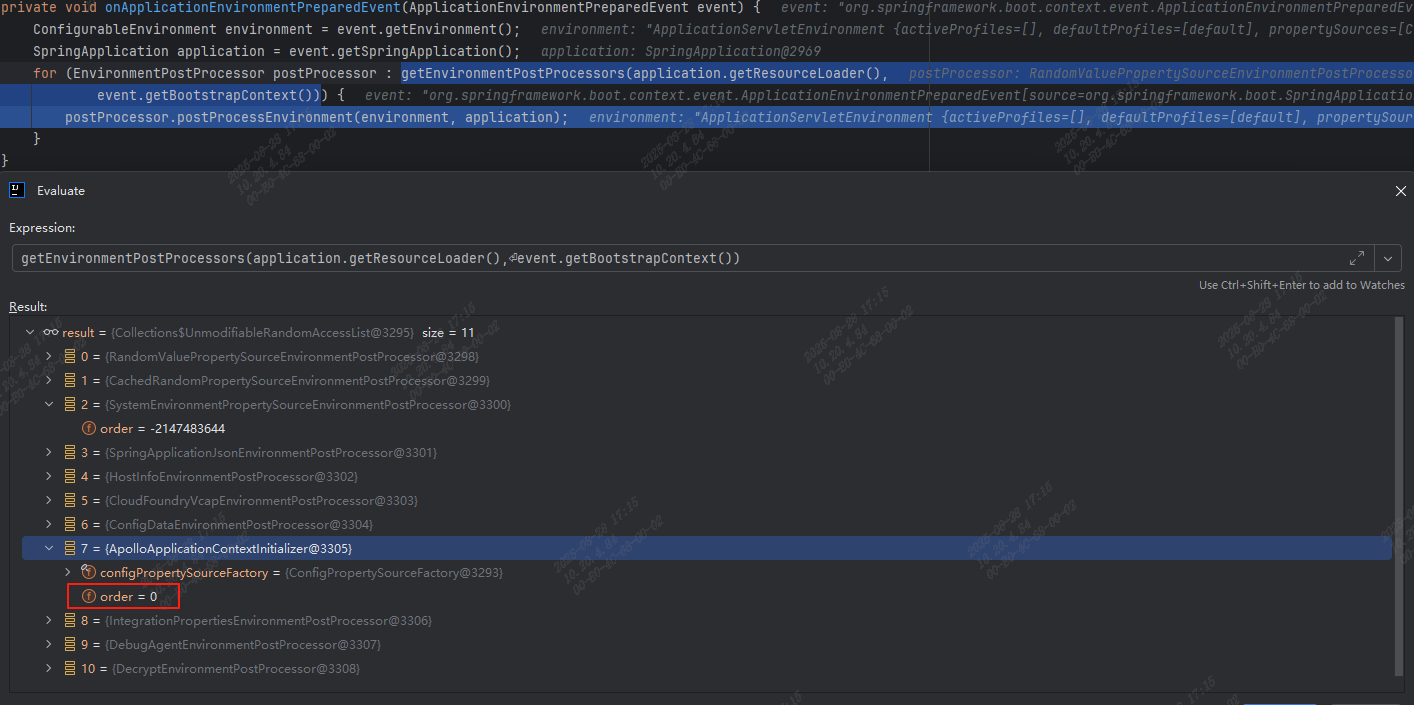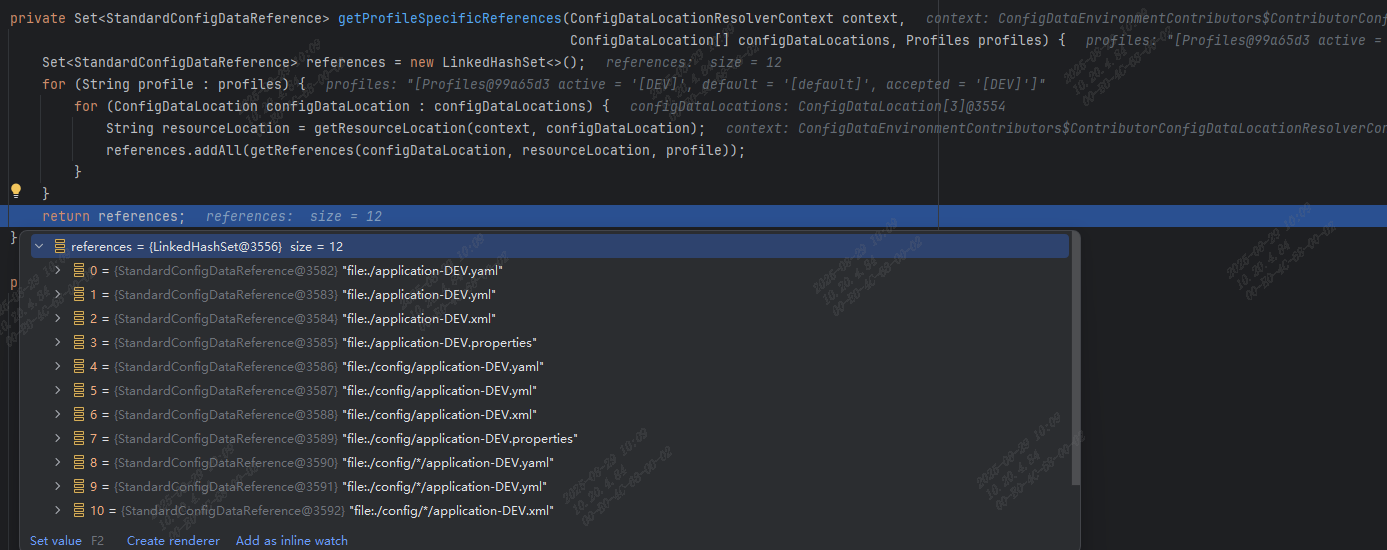深入認識ClassLoader - 一次投產(chǎn)失敗的復盤
問題背景
投產(chǎn)日,同事負責的項目新版本發(fā)布,版本包是SpringBoot v2.7.18的一個FatJar,java -jar啟動報錯停止了,輸出的異常日志如下:
Caused by: org.springframework.beans.factory.BeanCreationException: Error creating bean with name 'dataSource' defined in class path resource [com/alibaba/druid/spring/boot/autoconfigure/DruidDataSourceAutoConfigure.class]: Invocation of init method failed; nested exception is org.springframework.boot.autoconfigure.jdbc.DataSourceProperties$DataSourceBeanCreationException: Failed to determine a suitable driver class
...省略
Caused by: org.springframework.boot.autoconfigure.jdbc.DataSourceProperties$DataSourceBeanCreationException: Failed to determine a suitable driver class
at org.springframework.boot.autoconfigure.jdbc.DataSourceProperties.determineDriverClassName(DataSourceProperties.java:186)
at org.springframework.boot.autoconfigure.jdbc.DataSourceProperties.determineUsername(DataSourceProperties.java:280)
at com.alibaba.druid.spring.boot.autoconfigure.DruidDataSourceWrapper.afterPropertiesSet(DruidDataSourceWrapper.java:40)
...省略
版本回退,正好我也在旁邊,記錄下一起排查解決的過程。
定位與解決問題
分析錯誤日志
拉了版本分支代碼,從下往上看輸出的錯誤日志,發(fā)現(xiàn)是DruidDataSourceWrapper這個類中40行出錯,看下這個類以及出錯的位置:
@ConfigurationProperties("spring.datasource.druid")
class DruidDataSourceWrapper extends DruidDataSource implements InitializingBean {
@Autowired
private DataSourceProperties basicProperties;
@Override
public void afterPropertiesSet() throws Exception {
//if not found prefix 'spring.datasource.druid' jdbc properties ,'spring.datasource' prefix jdbc properties will be used.
if (super.getUsername() == null) {
// 關鍵行:這一行出錯,basicProperties.determineUsername()這個方法會出現(xiàn)異常
super.setUsername(basicProperties.determineUsername());
}
if (super.getPassword() == null) {
super.setPassword(basicProperties.determinePassword());
}
if (super.getUrl() == null) {
super.setUrl(basicProperties.determineUrl());
}
if (super.getDriverClassName() == null) {
super.setDriverClassName(basicProperties.getDriverClassName());
}
}
...
DruidDataSourceWrapper歸屬于druid-spring-boot-starter這個依賴,是 alibaba druid 數(shù)據(jù)庫連接池的一個 starter。
結合錯誤日志看下basicProperties.determineUsername()這個方法里面出錯的位置:
public String determineUsername() {
if (StringUtils.hasText(this.username)) {
return this.username;
}
// 關鍵行:調用determineDriverClassName()這個方法出錯
if (EmbeddedDatabaseConnection.isEmbedded(determineDriverClassName(), determineUrl())) {
return "sa";
}
return null;
}
再次結合錯誤日志看下determineDriverClassName()這個方法里面出錯的位置:
public String determineDriverClassName() {
if (StringUtils.hasText(this.driverClassName)) {
Assert.state(driverClassIsLoadable(), () -> "Cannot load driver class: " + this.driverClassName);
return this.driverClassName;
}
String driverClassName = null;
if (StringUtils.hasText(this.url)) {
driverClassName = DatabaseDriver.fromJdbcUrl(this.url).getDriverClassName();
}
if (!StringUtils.hasText(driverClassName)) {
driverClassName = this.embeddedDatabaseConnection.getDriverClassName();
}
if (!StringUtils.hasText(driverClassName)) {
// 關鍵行:在這邊拋出的異常
throw new DataSourceBeanCreationException("Failed to determine a suitable driver class", this,
this.embeddedDatabaseConnection);
}
return driverClassName;
}
定位到了出錯的位置,分析這塊代碼拋出異常的原因,意思就是如果spring.datasource.druid.username這個配置的值為空,那么讀取spring.datasource.username這個配置,如果還是空,嘗試從spring.datasource.url配置信息中解析jdbc驅動類,解析不出來就拋出DataSourceBeanCreationException異常。
版本變動點
是配置信息有問題?
問了下這個項目的配置原本是放在配置文件中的,公共配置放在了application.yml中,不同環(huán)境的配置采用application-{profile}.yml放置,如下:
application.yml
application-dev.yml
...
application-pro.yml
在application.yml中使用占位符借助 maven 打包時添加-P參數(shù)設置激活的profile:
spring:
profiles:
# env
active: @env@
項目 pom 文件中多個 profile 配置如下(這是本次版本的一個變動點):
<profiles>
<!-- DEV 開發(fā)環(huán)境-->
<profile>
<id>dev</id>
<properties>
<env>DEV</env>
...
</properties>
</profile>
...
<!-- PRO 生產(chǎn)環(huán)境-->
<profile>
<id>pro</id>
<properties>
<env>PRO</env>
...
</properties>
</profile>
</profiles>
maven 打生產(chǎn)包,spring.profiles.active的值被設置成了PRO,也就是生產(chǎn)環(huán)境將使用application-PRO.yml這個配置文件。
這個版本的另一個變動點是接入了 apollo 配置中心,但是沒有刪除不同環(huán)境的配置文件,配置文件application.yml中增加了 apollo 相關的配置:
app:
id: app-xxx-web
apollo:
bootstrap:
namespaces: application
enabled: true
eagerLoad:
enabled: true
分析 SpringBoot 的配置加載流程
觸發(fā)時機
SpringBoot 應用啟動時在 SpringApplication prepareEnvironment方法中發(fā)布ApplicationEnvironmentPreparedEvent事件,EnvironmentPostProcessorApplicationListener 中監(jiān)聽了這個事件觸發(fā)配置信息讀取,不同來源的配置信息有專門實現(xiàn)了EnvironmentPostProcessor接口的類進行處理,這些類實現(xiàn)postProcessEnvironment方法,apollo-client使用的是v1.9.0版本,其包含一個META-INF/spring.factories:
org.springframework.boot.autoconfigure.EnableAutoConfiguration=\
com.ctrip.framework.apollo.spring.boot.ApolloAutoConfiguration
org.springframework.context.ApplicationContextInitializer=\
com.ctrip.framework.apollo.spring.boot.ApolloApplicationContextInitializer
org.springframework.boot.env.EnvironmentPostProcessor=\
com.ctrip.framework.apollo.spring.boot.ApolloApplicationContextInitializer
com.ctrip.framework.apollo.spring.boot.ApolloApplicationContextInitializer 會被掃描到,然后執(zhí)行其postProcessEnvironment方法,多個EnvironmentPostProcessor的執(zhí)行順序由其內部的order屬性決定,越小的越靠前,ApolloApplicationContextInitializer的order為0,屬于是靠后的:

SpringBoot 中,后加載的屬性源可以覆蓋先加載的屬性源定義的值,參考:屬性源的優(yōu)先級順序,因此 apollo 中的配置會覆蓋配置文件中的配置。
難道是 apollo 中的配置寫錯了?
看了下 apollo 中沒有spring.datasource.url這個配置,數(shù)據(jù)庫的連接信息是寫在spring.datasource.druid這個前綴開頭下面的,apollo 中有兩個名為application的命名空間,一個格式是properties,另一個格式是yml,這些配置是寫在yml格式命名空間下的,properties格式命名空間下的配置為空。
spring:
# druid pool
datasource:
druid:
url: jdbc:mysql://...:3306/...?useUnicode=true&characterEncoding=UTF-8&useSSL=false&...
username: ...
password: ...
driver-class-name: com.mysql.cj.jdbc.Driver
type: com.alibaba.druid.pool.DruidDataSource
...
idea 啟動參數(shù)指定 apollo 配置,啟動項目,本地 apollo 的緩存文件夾config-cache下是有配置文件存在的,不過只有一個文件app-xx-web+default+application.properties,里面是空的。
yml格式命名空間下的配置呢?
看了下 apollo 的文檔,原來yml格式命名空間下的配置在客戶端使用需要填寫帶后綴的完整名字。
注1:yaml/yml格式的namespace從1.3.0版本開始支持和Spring整合,注入時需要填寫帶后綴的完整名字,比如application.yml
注2:非properties、非yaml/yml格式(如xml,json等)的namespace暫不支持和Spring整合。
配置文件application.yml中修改apollo的配置,將namespaces從application修改為application.yml:
app:
id: app-xxx-web
apollo:
bootstrap:
namespaces: application.yml
enabled: true
eagerLoad:
enabled: true
本地調試啟動ok,apollo 中的配置可以正常拉取,項目啟動成功。
生產(chǎn)環(huán)境 apollo 中的配置沒有生效的話,可application-{profile}.yml文件還在,應該還是能讀取配置文件中的配置完成啟動的吧?
額,不對, maven 打生產(chǎn)包,spring.profiles.active的值被設置成了PRO,但classpath下生產(chǎn)環(huán)境配置文件名稱為 application-pro.yml,大小寫不一致,能正常加載嗎?
將application.yml配置文件中的app.apollo.bootstrap.namespaces配置還原,在 maven 的 Profiles 中勾選 dev ,spring.profiles.active的值被設置成了DEV,idea 中正常啟動項目,說明 application-dev.yml這個配置文件被讀取了。
拿生產(chǎn)包在本地java -jar啟動,apollo 的配置服務器指定為dev環(huán)境,和生產(chǎn)環(huán)境報一樣的錯誤:
java -Dapp.id=app-xxx-web -Dapollo.meta=http://10.100.x.x:8072 -jar app-xxx-web.jar
難道是 CICD 打包的問題?
沒有加載的配置文件
本地打了一個包,啟動也是報一樣的錯誤,奇怪了,idea 里面啟動和打成 FatJar 之后啟動的行為還不一樣。
idea 里面啟動,spring.profiles.active 的值是大寫的 DEV,application-dev.yml中的配置是能正常讀取的,打成FatJar之后,spring.profiles.active的值是大寫的 PRO,application-pro.yml中的配置卻不能正常讀取。
apollo 的 app.id 這個配置是放在application.yml中的,啟動后本地 apollo 的配置緩存文件夾 config-cache 下是有配置的,說明 application.yml 是生效的,只是不同環(huán)境 application-{profile}.yml 文件中的配置沒有生效。
得著重看看 SpringBoot 中讀取配置文件的邏輯了。
配置文件的加載流程
上面分析到,EnvironmentPostProcessorApplicationListener 中監(jiān)聽了ApplicationEnvironmentPreparedEvent事件做配置信息讀取動作,不同來源的配置信息有專門實現(xiàn)了EnvironmentPostProcessor接口的類進行處理,配置文件的處理類是哪一個?
debug 看了下,是 ConfigDataEnvironmentPostProcessor,其 postProcessEnvironment 方法里面進行處理,然后調用了ConfigDataEnvironment類中的 processAndApply 方法,其內部會調用processWithProfiles方法:
private ConfigDataEnvironmentContributors processWithProfiles(ConfigDataEnvironmentContributors contributors,
ConfigDataImporter importer, ConfigDataActivationContext activationContext) {
this.logger.trace("Processing config data environment contributors with profile activation context");
// 在這~~~
contributors = contributors.withProcessedImports(importer, activationContext);
registerBootstrapBinder(contributors, activationContext, ALLOW_INACTIVE_BINDING);
return contributors;
}
此時的contributors是ConfigDataEnvironmentContributors,繼續(xù)跟蹤 withProcessedImports 方法,里面會調用是ConfigDataImporter的 resolveAndLoad 方法:
/**
* Resolve and load the given list of locations, filtering any that have been
* previously loaded.
* @param activationContext the activation context
* @param locationResolverContext the location resolver context
* @param loaderContext the loader context
* @param locations the locations to resolve
* @return a map of the loaded locations and data
*/
Map<ConfigDataResolutionResult, ConfigData> resolveAndLoad(ConfigDataActivationContext activationContext,
ConfigDataLocationResolverContext locationResolverContext, ConfigDataLoaderContext loaderContext,
List<ConfigDataLocation> locations) {
try {
// 關鍵行:定位出使用的環(huán)境profile
Profiles profiles = (activationContext != null) ? activationContext.getProfiles() : null;
// 關鍵行:根據(jù)profile列出需要查找的配置文件列表
List<ConfigDataResolutionResult> resolved = resolve(locationResolverContext, profiles, locations);
return load(loaderContext, resolved);
}
catch (IOException ex) {
throw new IllegalStateException("IO error on loading imports from " + locations, ex);
}
}
因為我本地 debug 的時候 profile 指定的 dev,所以spring.profiles.active的值被設置成了DEV:

繼續(xù)斷點,跟蹤到了StandardConfigDataLocationResolver類,其 getProfileSpecificReferences 方法中根據(jù) profile 列出需要讀取的配置文件路徑列表:


繼續(xù)斷點到了獲取配置文件資源的位置,是 resolveNonPattern 方法:
private List<StandardConfigDataResource> resolveNonPattern(StandardConfigDataReference reference) {
// 關鍵行:通過統(tǒng)一的 ResourceLoader 接口獲取資源
Resource resource = this.resourceLoader.getResource(reference.getResourceLocation());
// 關鍵行:調用 Resource.exists() 方法,如果文件存在,則繼續(xù)在后面讀取,否則忽略
if (!resource.exists() && reference.isSkippable()) {
logSkippingResource(reference);
return Collections.emptyList();
}
return Collections.singletonList(createConfigResourceLocation(reference, resource));
}
因為 application-DEV.yml 是放在classpath下,在這加一個條件斷點,只關注application-DEV.yml:
reference.getResourceLocation().equals("classpath:/application-DEV.yml");
判斷文件是否存在這個語句執(zhí)行的結果是存在的:

可見spring.profiles.active的值被設置成了DEV,本地在 idea 中 debug 項目代碼也能正常加載 application-dev.yml ,會不會是打成 jar 包之后就不行呢?
遠程調試生產(chǎn)包
idea 支持** Remote JVM Debug** ,我想要觀測下生產(chǎn)版本 jar 包啟動的時候,spring.profiles.active的值被設置成了PRO,這塊代碼判斷 classpath:/application-PRO.yml 文件是否存在的結果。
在生產(chǎn) jar 包目錄下打開命令行窗口,執(zhí)行以下命令,其中 suspend 需要設置成 y,代表回車執(zhí)行命令需要等到 idea 連接到這個 5005 調試端口之后才繼續(xù)執(zhí)行程序:
java -agentlib:jdwp=transport=dt_socket,server=y,suspend=y,address=5005 -Dapollo.meta=http://10.100.x.xx:8072 -jar app-xxx-web.jar --logging.level.root=TRACE
因為是生產(chǎn)包,所以需要改下條件斷點為:
reference.getResourceLocation().equals("classpath:/application-PRO.yml");
Remote JVM Debug 啟動后 , 判斷 classpath:/application-PRO.yml 文件是否存在的結果為false,和 debug 項目代碼不一樣了:

改成 classpath:/application-pro.yml 呢?在斷點處執(zhí)行以下命令,判斷結果為 true了:

解決方案
分析到這,問題點和解決方案已經(jīng)出來了:
- 項目 pom 文件中 profile 設置的 env 參數(shù)值本該小寫但是用了大寫
- 全面使用 apollo,去掉不同環(huán)境的配置文件,修正 apollo 命名空間配置為: apollo.bootstrap.namespaces = application.yml
可為什么測試環(huán)境沒有出現(xiàn)這個問題呢,原來測試環(huán)境的啟動腳本中指定了spring.profiles.active的值且是小寫,生產(chǎn)環(huán)境啟動腳本卻沒有指定。
??
深入認識 ClassLoader
不一樣的 ClassLoader
版本能正常投產(chǎn)了,但是同一份代碼不同的啟動方式卻有不同的表現(xiàn),這著實讓我費解,想著空余花點時間來弄明白這其中的原理。
resolveNonPattern 這個方法里面調用了resource.exists()方法判斷配置文件是否存在,resource 是 spring-core 提供的 org.springframework.core.io.ClassPathResource 類:
/**
* {@link Resource} implementation for class path resources. Uses either a
* given {@link ClassLoader} or a given {@link Class} for loading resources.
*
* <p>Supports resolution as {@code java.io.File} if the class path
* resource resides in the file system, but not for resources in a JAR.
* Always supports resolution as {@code java.net.URL}.
*
* ...
*/
public class ClassPathResource extends AbstractFileResolvingResource {
private final String path;
@Nullable
private ClassLoader classLoader;
@Nullable
private Class<?> clazz;
/**
* This implementation checks for the resolution of a resource URL.
* @see ClassLoader#getResource(String)
* @see Class#getResource(String)
*/
@Override
public boolean exists() {
return (resolveURL() != null);
}
/**
* Resolves a URL for the underlying class path resource.
* @return the resolved URL, or {@code null} if not resolvable
*/
@Nullable
protected URL resolveURL() {
try {
if (this.clazz != null) {
return this.clazz.getResource(this.path);
}
else if (this.classLoader != null) {
// 關鍵行:委托給具體的 ClassLoader
return this.classLoader.getResource(this.path);
}
else {
return ClassLoader.getSystemResource(this.path);
}
}
catch (IllegalArgumentException ex) {
// Should not happen according to the JDK's contract:
// see https://github.com/openjdk/jdk/pull/2662
return null;
}
}
...
}
2.7.18 版本的 SpringBoot 使用的 spring-core 版本為 5.3.31,exists() 方法會調用本類中的 resolveURL() 方法,debug 看了下,不管是 idea 啟動還是打成 jar 之后啟動,resolveURL 方法中都是通過return this.classLoader.getResource(this.path)返回配置文件的 URL 的,區(qū)別在于:
- idea 中啟動時,
classLoader為Launcher$AppClassLoader,exists方法中return (resolveURL() != null)的返回值為 true - 打成 jar 之后啟動,
classLoader為LaunchedURLClassLoader,exists方法中return (resolveURL() != null)的返回值為 false
Launcher$AppClassLoader 與 LaunchedURLClassLoader 的差異
類加載器的架構差異
Launcher$AppClassLoader 是 JDK 標準的三層類加載器架構中的系統(tǒng)類加載器:
// JDK 類加載器層次結構
Bootstrap ClassLoader (C++實現(xiàn),加載JRE核心類)
↓
Extension ClassLoader (加載JRE擴展包)
↓
AppClassLoader (系統(tǒng)類加載器,加載-classpath指定路徑)
在 idea 環(huán)境中運行時,應用類路徑由 idea 動態(tài)構建,通常包含:
項目編譯輸出目錄(如target/classes)
所有依賴的 JAR 文件
idea 特定的資源目錄
此時的資源查找基于文件系統(tǒng),ClassLoader.getResource()方法會遍歷類路徑中的每個條目,在文件系統(tǒng)上直接查找對應的資源文件。
LaunchedURLClassLoader 是 SpringBoot 為 FatJar 設計的特殊類加載器:
// SpringBoot FatJar 類加載架構
LaunchedURLClassLoader
↓
URLClassLoader
↓
ClassLoader (父類加載器)
其特殊之處在于能夠處理"嵌套的JAR"(nested JARs)——即 FatJar 中內嵌的其他 JAR 文件。
資源解析機制的對比
AppClassLoader 的資源解析流程:
// 簡化版的資源查找邏輯
public URL getResource(String name) {
URL url;
// 首先委托父加載器查找
if (parent != null) {
url = parent.getResource(name);
} else {
url = getBootstrapResource(name);
}
if (url == null) {
// 在自身的類路徑中查找
url = findResource(name);
}
return url;
}
// 在文件系統(tǒng)中的查找
URL findResource(String name) {
for (File classpathEntry : classpath) {
File resourceFile = new File(classpathEntry, name);
if (resourceFile.exists()) {
return resourceFile.toURI().toURL();
}
}
return null;
}
關鍵特性:
基于文件系統(tǒng)路徑直接查找
受操作系統(tǒng)文件系統(tǒng)大小寫規(guī)則影響(Windows 不敏感,Linux 敏感)
支持通配符和模式匹配
LaunchedURLClassLoader 的資源解析流程:
// SpringBoot 自定義的資源查找
public URL findResource(String name) {
// 1. 首先嘗試從已索引的資源中查找
URL url = findResourceFromIndex(name);
if (url != null) {
return url;
}
// 2. 在嵌套的JAR文件中查找
for (JarFile jar : nestedJars) {
JarEntry entry = jar.getJarEntry(name);
if (entry != null) {
try {
// 創(chuàng)建特殊的URL指向JAR內的資源
return createJarUrl(jar, entry);
} catch (IOException e) {
// 處理異常
}
}
}
// 3. 回退到標準的URLClassLoader查找
return super.findResource(name);
}
關鍵特性:
基于 JAR 文件條目的精確匹配
嚴格的大小寫敏感性(ZIP/JAR實現(xiàn)的實際要求)
需要預先構建資源索引以提高性能
FatJar 中的資源定位機制
SpringBoot FatJar 的特殊結構:
app.jar
├── META-INF/
├── BOOT-INF/
│ ├── classes/ # 應用類文件
│ │ └── application.yml
│ └── lib/ # 依賴庫
│ ├── spring-core.jar
│ └── druid.jar
└── org/springframework/boot/loader/
├── Launcher.class
└── LaunchedURLClassLoader.class
資源解析的核心挑戰(zhàn):
- JAR 規(guī)范的限制:
- JAR 文件本質上是 ZIP 文件
- 嚴格的大小寫敏感性(ZIP/JAR實現(xiàn)的實際要求),
application-PRO.yml≠application-pro.yml
SpringBoot 的優(yōu)化策略:
// SpringBoot 在構建時創(chuàng)建資源索引
private Map<String, List<String>> createResourceIndex() {
Map<String, List<String>> index = new HashMap<>();
for (JarFile jar : getAllJars()) {
Enumeration<JarEntry> entries = jar.entries();
while (entries.hasMoreElements()) {
JarEntry entry = entries.nextElement();
if (!entry.isDirectory()) {
String path = entry.getName();
// 將路徑轉換為標準形式
String normalized = normalizePath(path);
index.computeIfAbsent(normalized, k -> new ArrayList<>())
.add(path);
}
}
}
return index;
}
- 類加載器的初始化差異:
- idea 環(huán)境:類路徑包含具體的目錄和文件
- FatJar 環(huán)境:類路徑指向 JAR 文件內部的嵌套結構
操作系統(tǒng)的影響
開發(fā)環(huán)境(Windows):
// 文件系統(tǒng)級別的大小寫處理
File file = new File("application-PRO.yml");
System.out.println(file.exists());
// Windows: 如果存在application-pro.yml,可能返回true(不敏感)
// Linux: 嚴格返回false(敏感)
生產(chǎn)環(huán)境(Linux):
// JAR文件內部的資源查找
JarFile jar = new JarFile("app.jar");
JarEntry entry1 = jar.getJarEntry("application-PRO.yml"); // null
JarEntry entry2 = jar.getJarEntry("application-pro.yml"); // 找到條目
SpringBoot 配置加載的完整鏈條
理解整個配置加載過程中 ClassLoader 的作用:
// 配置解析的完整調用鏈
ConfigDataEnvironmentPostProcessor.postProcessEnvironment()
→ ConfigDataEnvironment.processAndApply()
→ ConfigDataImporter.resolveAndLoad()
→ StandardConfigDataLocationResolver.resolve()
→ ClassPathResource.exists()
→ LaunchedURLClassLoader.getResource()
→ JarFile.getJarEntry() // 嚴格大小寫匹配
關鍵發(fā)現(xiàn):
- 在 FatJar 中,資源查找最終委托給
java.util.jar.JarFile JarFile.getJarEntry()方法基于哈希表實現(xiàn),要求精確的鍵匹配- 哈希鍵的計算基于原始字節(jié),不進行大小寫轉換
問題復現(xiàn)的技術根源
通過源碼分析,可以精確重現(xiàn)問題:
// 問題重現(xiàn)的偽代碼
public class ProblemReproduction {
public static void main(String[] args) {
// 開發(fā)環(huán)境(IDE)
ClassLoader devLoader = Launcher.AppClassLoader;
URL devResource = devLoader.getResource("application-PRO.yml");
System.out.println("DEV Found: " + (devResource != null)); // true
// 生產(chǎn)環(huán)境(FatJar)
ClassLoader prodLoader = new LaunchedURLClassLoader();
URL prodResource = prodLoader.getResource("application-PRO.yml");
System.out.println("PROD Found: " + (prodResource != null)); // false
// 實際存在的文件
URL actualResource = prodLoader.getResource("application-pro.yml");
System.out.println("Actual Found: " + (actualResource != null)); // true
}
}
設計啟示與最佳實踐
架構層面的啟示:
- 環(huán)境一致性:開發(fā)、測試、生產(chǎn)環(huán)境的運行時行為應該盡可能一致
- 早期驗證:在構建階段就應該檢測配置文件和類路徑的一致性
- 防御性編程:對資源加載進行適當?shù)娜蒎e處理
技術實踐建議:
// 防御性的資源配置加載
public class SafeConfigLoader {
public static Resource loadConfig(ClassLoader loader, String baseName, String profile) {
// 嘗試規(guī)范化的命名
String[] possibleNames = {
baseName + "-" + profile.toLowerCase() + ".yml",
baseName + "-" + profile.toUpperCase() + ".yml",
baseName + "-" + profile + ".yml"
};
for (String name : possibleNames) {
Resource resource = loader.getResource(name);
if (resource != null && resource.exists()) {
return resource;
}
}
return null;
}
}
構建期檢查:
<!-- Maven 構建期資源驗證 -->
<plugin>
<groupId>org.apache.maven.plugins</groupId>
<artifactId>maven-enforcer-plugin</artifactId>
<configuration>
<rules>
<requireFilesExist>
<files>
<!-- 驗證配置文件命名一致性 -->
<file>src/main/resources/application-${env}.yml</file>
</files>
</requireFilesExist>
</rules>
</configuration>
</plugin>
本文來自博客園,作者:杜勁松,轉載請注明原文鏈接:http://www.rzrgm.cn/imadc/p/19156192




 浙公網(wǎng)安備 33010602011771號
浙公網(wǎng)安備 33010602011771號